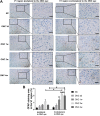Reduced Dendritic Spines in the Visual Cortex Contralateral to the Optic Nerve Crush Eye in Adult Mice
- PMID: 32866269
- PMCID: PMC7463183
- DOI: 10.1167/iovs.61.10.55
Reduced Dendritic Spines in the Visual Cortex Contralateral to the Optic Nerve Crush Eye in Adult Mice
Abstract
Purpose: To determine alteration of dendritic spines and associated changes in the primary visual cortex (V1 region) related to unilateral optic nerve crush (ONC) in adult mice.
Methods: Adult unilateral ONC mice were established. Retinal nerve fiber layer (RNFL) thickness was measured by spectral-domain optical coherence tomography. Visual function was estimated by flash visual evoked potentials (FVEPs). Dendritic spines were observed in the V1 region contralateral to the ONC eye by two-photon imaging in vivo. The neurons, reactive astrocytes, oligodendrocytes, and activated microglia were assessed by NeuN, glial fibrillary acidic protein, CNPase, and CD68 in immunohistochemistry, respectively. Tropomyosin receptor kinase B (TrkB) and the markers in TrkB trafficking were estimated using western blotting and co-immunoprecipitation. Transmission electron microscopy and western blotting were used to evaluate autophagy.
Results: The amplitude and latency of FVEPs were decreased and delayed at 3 days, 1 week, 2 weeks, and 4 weeks after ONC, and RNFL thickness was decreased at 2 and 4 weeks after ONC. Dendritic spines were reduced in the V1 region contralateral to the ONC eye at 2, 3, and 4 weeks after ONC, with an unchanged number of neurons. Reactive astrocyte staining was increased at 2 and 4 weeks after ONC, but oligodendrocyte and activated microglia staining remained unchanged. TrkB was reduced with changes in the major trafficking proteins, and enhanced autophagy was observed in the V1 region contralateral to the ONC eye.
Conclusions: Dendritic spines were reduced in the V1 region contralateral to the ONC eye in adult mice. Reactive astrocytes and decreased TrkB may be associated with the reduced dendritic spines.
Conflict of interest statement
Disclosure:
Figures









References
-
- Gilbert CD, Wiesel TN. Receptive field dynamics in adult primary visual cortex. Nature. 1992; 356: 150–152. - PubMed
-
- Hofer SB, Mrsic-Flogel TD, Bonhoeffer T, Hubener M. Lifelong learning: ocular dominance plasticity in mouse visual cortex. Curr Opin Neurobiol. 2006; 16: 451–459. - PubMed
-
- Sengpiel F. Plasticity of the visual cortex and treatment of amblyopia. Curr Biol. 2014; 24: R936–R940. - PubMed
Publication types
MeSH terms
LinkOut - more resources
Full Text Sources
Medical

